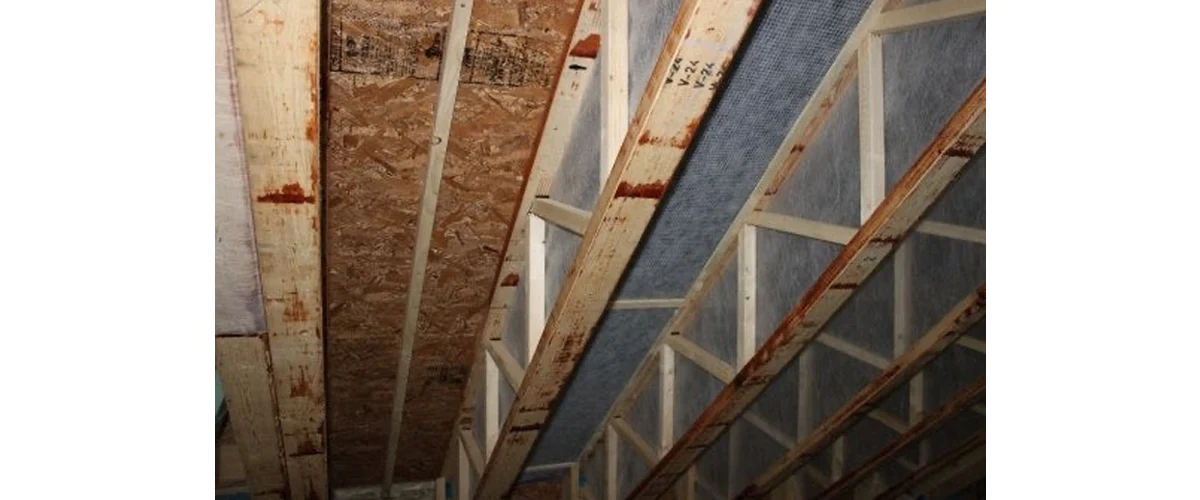Can't vent at valleys and dormers?
Use a smart vapor retarder (not foam)

Typical reactions to complicated designs and difficulty venting roofs at dormers, valleys and even cathedral ceilings are the following:
To add a layer of spray foam - presumably airtight - so interior humid air doesn't reach the cold sheathing. (For evidence of spray foam's pitfalls, see this Energy Vanguard post showing air leakage sites and foam pulling away from framing, and likelihood of gaps in foam.) Foam airtightness is further compromised in roof valleys/trusses, where large numbers of mitered wood intersections are practically impossible to perfectly airseal with foam.or
add several inches of foam on top of the sheathing (some issues regarding shrinking EPS foam board here - and polyisocyanurate foam board here) and call it good.But if you are rebuilding your house - and do not appreciate the flame-retardants/chemical composition, fire hazard, diminishing r-values and shrinking properties of foam - then vapor variable retarders are the solution for preventing condensation on the underside of your sheathing.Venting under sheathing with a vapor open membraneAlex, working with contractor Eli Gould of Ironwood Brand, used a clever venting system when he was renovating his house. Under the conventional existing roof deck he offset strips of airtight and vapor open ProClima SOLITEX MENTO Plus. This monolithic but actively vapor open material makes sure there is no wind washing of the air that is venting between this membrane and the sheathing. This venting of course assures that the sheathing stays dry, even if the membrane passes any unforeseen moisture outward that might have entered the insulated cavity below (either by diffusion or an airleak).

 Similar detail showing back venting under existing sheathing.Using vapor variable retarders at valleys and dormers that can't be ventedThe insulation used in this project was JM Spider, and was installed before the inboard airtight layer/smart vapor retarder DB+. Because of the DB+ reinforcement grid, other fiberglass insulations could have been dense packed in these deep trusses after the membrane was installed (Knauf Jetstream, Owen Corning ProPinkL77, etc...).
Similar detail showing back venting under existing sheathing.Using vapor variable retarders at valleys and dormers that can't be ventedThe insulation used in this project was JM Spider, and was installed before the inboard airtight layer/smart vapor retarder DB+. Because of the DB+ reinforcement grid, other fiberglass insulations could have been dense packed in these deep trusses after the membrane was installed (Knauf Jetstream, Owen Corning ProPinkL77, etc...). (C) Alex Wilson- Left installation of BIBS insulation over SOLITEX MENTO Plus - note strip of DB+ pre-installed behind rafter right photo DB+ installed over shaved back spider as airtight/smart vapor retarderDB+, made by Pro Clima, is a paper-based membrane with 50% recycled content. It contains a small amount of PE, which gives it a vapor variability from 0.8 to 5.5 perms. When installed with the pressure sensitive solid acrylic Pro Clima TESCON Vana tape, DB+ can produce very airtight buildings, including Passive Houses below 0.6ACH50.
(C) Alex Wilson- Left installation of BIBS insulation over SOLITEX MENTO Plus - note strip of DB+ pre-installed behind rafter right photo DB+ installed over shaved back spider as airtight/smart vapor retarderDB+, made by Pro Clima, is a paper-based membrane with 50% recycled content. It contains a small amount of PE, which gives it a vapor variability from 0.8 to 5.5 perms. When installed with the pressure sensitive solid acrylic Pro Clima TESCON Vana tape, DB+ can produce very airtight buildings, including Passive Houses below 0.6ACH50. WUFI study for Holzkirchen, Germany of drying potentials of roofs - similar but slightly warmer winter (5-8F) than Brattleboro, VTIn winter conditions, DB+ is vapor closed (class II) and protects the sheathing against condensation, even at unvented valleys and dormers. However, the membrane opens up in warmer conditions when vapor is driven inwards, and makes sure the assembly stay dry if small amounts of moisture enter the insulated cavity. It is important to perform a WUFI study for assemblies that are particularly demanding (steep and north facing roof, or shaded enclosures). In some cases this will show that you should use INTELLO, an intelligent vapor retarder with the largest vapor variable properties available on the market (0.17 to > 13 perm range) - which can give even those very demanding roofs or walls a drying reserve that exceeds their unanticipated moisture stress.More info on the Alex Wilson's project can be found in various BuildingGreen blogposts: Smart vapor retarders, not just your grandmother's Poly Getting to know spider insulation Smart vapor retarders GreenbuildingAdvisor blogpost - (GBA members only) With interesting conversation and comments for those who are interested in perm ratings of latex paint on sheetrock (FYI, we consider latex paint a vapor permeable material between 8-15 perms)
WUFI study for Holzkirchen, Germany of drying potentials of roofs - similar but slightly warmer winter (5-8F) than Brattleboro, VTIn winter conditions, DB+ is vapor closed (class II) and protects the sheathing against condensation, even at unvented valleys and dormers. However, the membrane opens up in warmer conditions when vapor is driven inwards, and makes sure the assembly stay dry if small amounts of moisture enter the insulated cavity. It is important to perform a WUFI study for assemblies that are particularly demanding (steep and north facing roof, or shaded enclosures). In some cases this will show that you should use INTELLO, an intelligent vapor retarder with the largest vapor variable properties available on the market (0.17 to > 13 perm range) - which can give even those very demanding roofs or walls a drying reserve that exceeds their unanticipated moisture stress.More info on the Alex Wilson's project can be found in various BuildingGreen blogposts: Smart vapor retarders, not just your grandmother's Poly Getting to know spider insulation Smart vapor retarders GreenbuildingAdvisor blogpost - (GBA members only) With interesting conversation and comments for those who are interested in perm ratings of latex paint on sheetrock (FYI, we consider latex paint a vapor permeable material between 8-15 perms)



